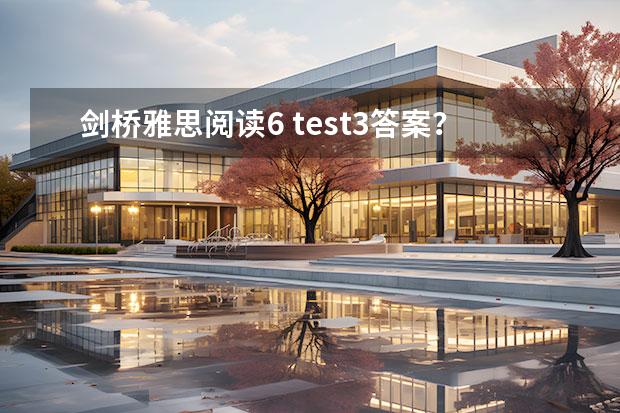今天金博宝188官网小编整理了剑桥雅思阅读6 test3答案?(剑桥雅思阅读AUSTRALIA’SSPORTINGSUCCESS及答案解析)相关信息,希望在这方面能够更好的大家。
本文目录一览:

剑桥雅思阅读6 test3答案?
关键词: 3000 BC, cocoon, fell into, emperor's wife
定位原文: 第1段第5句“It just so happened that... ” 这些蚕茧中的一粒掉进了热茶中并开始松散成为一根细丝。
解题思路: “3000BC”和“皇帝的妻子”都很好定位,在第一段的第二句中便可看到,但却偏偏没有“掉进”这个信息,直到读者看到第五句中的landed in这个同义表述才能恍然大悟,答案为tea。
【附解析】
Question 2
答案: reel
关键词: emperor's wife, invented, pull out silk fibres
定位原文: 第1段第8句“She also devised a special reel to draw... ”她还设计发明了一种特殊的卷轴来将蚕茧中的纤维纺成丝线。
解题思路: 此题的定位距离上一道题不远,仍是皇帝妻子所做的事。题干说“皇帝的妻子发明了一个 _____ 来拽出丝绸纤维”,读者只需回到原文找到devised这个对invented进行同义表述的单词,即不难发现答案为reel。
剑桥雅思阅读AUSTRALIA’SSPORTINGSUCCESS及答案解析
做好雅思的阅读题除了掌握对的 方法 ,也离不开我们日常的辛勤练习,下面我给大家带来剑桥雅思阅读AUSTRALIA’S SPORTING SUCCESS及答案解析,一起加油吧!
剑桥雅思阅读AUSTRALIA’S SPORTING SUCCESS
READING PASSAGE 1
You should spend about 20 minutes on Questions 1-13, which are based on Reading Passage 1 below.
AUSTRALIA’S SPORTING SUCCESS
A They play hard, they play often, and they play to win. Australian sports teams win more than their fair share of titles, demolishing rivals with seeming ease. How do they do it? A big part of the secret is an extensive and expensive network of sporting academies underpinned by science and medicine. At the Australian Institute of Sport (AIS), hundreds of youngsters and pros live and train under the eyes of coaches. Another body, the Australian Sports Commission (ASC), finances programmes of excellence in a total of 96 sports for thousands of sportsmen and women. Both provide intensive coaching, training facilities and nutritional advice.
B Inside the academies, science takes centre stage. The AIS employs more than 100 sports scientists and doctors, and collaborates with scores of others in universities and research centres. AIS scientists work across a number of sports, applying skills learned in one — such as building muscle strength in golfers — to others, such as swimming and squash. They are backed up by technicians who design instruments to collect data from athletes. They all focus on one aim: winning. ‘We can’t waste our time looking at ethereal scientific questions that don’t help the coach work with an athlete and improve performance,’ says Peter Fricker, chief of science at AIS.
C A lot of their work comes down to measurement — everything from the exact angle of a swimmer’s dive to the second-by-second power output of a cyclist. This data is used to wring improvements out of athletes. The focus is on individuals, tweaking performances to squeeze an extra hundredth of a second here, an extra millimetre there. No gain is too slight to bother with. It’s the tiny, gradual improvements that add up to world-beating results. To demonstrate how the system works, Bruce Mason at AIS shows off the prototype of a 3D analysis tool for studying swimmers. A wire-frame model of a champion swimmer slices through the water, her arms moving in slow motion. Looking side-on, Mason measures the distance between strokes. From above, he analyses how her spine swivels. When fully developed, this system will enable him to build a biomechanical profile for coaches to use to help budding swimmers. Mason’s contribution to sport also includes the development of the SWAN (Swimming Analysis) system now used in Australian national competitions. It collects images from digital cameras running at 50 frames a second and breaks down each part of a swimmer’s performance into factors that can be analysed individually — stroke length, stroke frequency, average duration of each stroke, velocity, start, lap and finish times, and so on. At the end of each race, SWAN spits out data on each swimmer.
D ‘Take a look,’ says Mason, pulling out a sheet of data. He points out the data on the swimmers in second and third place, which shows that the one who finished third actually swam faster. So why did he finish 35 hundredths of a second down? ‘His turn times were 44 hundredths of a second behind the other guy,’ says Mason. ‘If he can improve on his turns, he can do much better.’ This is the kind of accuracy that AIS scientists’ research is bringing to a range of sports. With the Cooperative Research Centre for Micro Technology in Melbourne, they are developing unobtrusive sensors that will be embedded in an athlete’s clothes or running shoes to monitor heart rate, sweating, heat production or any other factor that might have an impact on an athlete’s ability to run. There’s more to it than simply measuring performance. Fricker gives the example of athletes who may be down with coughs and colds 11 or 12 times a year. After years of experimentation, AIS and the University of Newcastle in New South Wales developed a test that measures how much of the immune-system protein immunoglobulin A is present in athletes’ saliva. If IgA levels suddenly fall below a certain level, training is eased or dropped altogether. Soon, IgA levels start rising again, and the danger passes. Since the tests were introduced, AIS athletes in all sports have been remarkably successful at staying healthy.
E Using data is a complex business. Well before a championship, sports scientists and coaches start to prepare the athlete by developing a ‘competition model’, based on what they expect will be the winning times.’ You design the model to make that time,’ says Mason.’ A start of this much, each free-swimming period has to be this fast, with a certain stroke frequency and stroke length, with turns done in these times.’ All the training is then geared towards making the athlete hit those targets, both overall and for each segment of the race. Techniques like these have transformed Australia into arguably the world’s most successful sporting nation.
F Of course, there’s nothing to stop other countries copying — and many have tried. Some years ago, the AIS unveiled coolant-lined jackets for endurance athletes. At the Atlanta Olympic Games in 1996, these sliced as much as two per cent off cyclists’ and rowers’ times. Now everyone uses them. The same has happened to the ‘altitude tent’, developed by AIS to replicate the effect of altitude training at sea level. But Australia’s success story is about more than easily copied technological fixes, and up to now no nation has replicated its all-encompassing system.
剑桥雅思阅读AUSTRALIA’S SPORTING SUCCESS题目
Questions 1-7
Reading Passage 1 has six paragraphs, A-F.
Which paragraph contains the following information?
Write the correct letter, A-F, in boxes 1-7 on your answer sheet.
NB You may use any letter more than once.
1 a reference to the exchange of expertise between different sports
2 an explanation of how visual imaging is employed in investigations
3 a reason for narrowing the scope of research activity
4 how some AIS ideas have been reproduced
5 how obstacles to optimum achievement can be investigated
6 an overview of the funded support of athletes
7 how performance requirements are calculated before an event
Questions 8-11
Classify the following techniques according to whether the writer states they
A are currently exclusively used by Australians
B will be used in the future by Australians
C are currently used by both Australians and their rivals
Write the correct letter, A, B or C, in boxes 8-11 on your answer sheet.
8 cameras
9 sensors
10 protein tests
11 altitude tents
Questions 12 and 13
Answer the questions below.
Choose NO MORE THAN THREE WORDS ANDIOR A NUMBER from the passage for each answer.
Write your answers in boxes 12 and 13 on your answer sheet.
12 What is produced to help an athlete plan their performance in an event?
13 By how much did some cyclists’ performance improve at the 1996 Olympic Games?
剑桥雅思阅读AUSTRALIA’S SPORTING SUCCESS答案
Question 1
答案:B
关键词:exchange of expertise, between different sports/collaborate, across a number of sports
定位原文:B段第2、3句“...and collaborates with… a number of sports …”
解题思路: 题干中讲到不同体育领域的专业知识交流正好跟原文中跨不同体育专家之间的合作相对应,理解意思即可容易找到正确答案。
Question 2
答案:C
关键词: visual imaging/3D, image
定位原文: C段第6句: “...shows off the prototype of a 3D analysis …”
解题思路: 通过题干中的视频成像可以很容易找到原文中对应的3D和成像。
Question 3
答案:B
关键词: a reason for narrowing/ can’t waste time
定位原文: B段最后1句: “We can’t waste our time looking…”
解题思路: 题目中的research activity和原文中的scientific questions 属于同义表达,定位答题区域,发现此句话所要表达的意思是不在一些飘渺的、不切实际的科学问题上浪费时间,也就是说要缩小研究的范围。
Question 4
答案:F
关键词:AIS ideas reproduce/ copying
定位原文: F段第1句话 “Of course, there’s nothing…”
解题思路: 题干中的reproduce是复制的意思,之后从 文章 中发现 句子 有复制copying,即可以直接定位。
Question 5
答案:D
关键词:Obstacle, investigated/ impact, monitor
定位原文: D段第6句“... to monitor heart rate…”
解题思路: 题干提到理想成绩的障碍是如何被调查研究的,而读到对应句子之后看到正好是sensors(传感器)对于运动员跑步的impact(影响)进行研究的仪器,而且obstacles和impact对应。
Question 6
答案:A
关键词:Overview, funded support finance
定位原文: A段倒数第2句 “...finances programmes of excellence…”
解题思路: finances是解题关键,意思为资助,正好跟题干中funded support表达了相同的义项,直接对应。而且之后一句话提及以上项目所提供的服务和建议,可以确信答案。
Question 7
答案:E
关键词:Calculated before an event/ using data, well before a championship
定位原文: E段第1句、第2句 “Using data is a complex business. Well before a championship, ...”
解题思路: 首先通过well before a championship和文章中before an event定位到E段, 之后发现后面提及的“竞争模型”作用就是计算时间和速率,因此内容对应上calculate,此时可断定答案的位置。
Question 8
答案:A
关键词: digital cameras
定位原文: C段倒数第3句: “..SWAN system now used in Australian national…”
解题思路: 前一句已经提到该系统已广泛应用于澳大利亚各项全国赛事之中,而没有提到其他国家,因此可以判断应该只有澳大利亚人在使用。
Question 9
答案:B
关键词:sensor
定位原文: D段第7句:“...With the Cooperative Research Centre for Micro…”
解题思路: 找到相同对应词sensor,读其前后的句子,发现有 Melbourne,断定是澳大利亚人的发明。之后要特别留心动词develop运用现在进行时,表示正在开发;而且注意之后的定语从句采用了将来时,所以可以断定此发明还没有完成,应该属于将来的成果。因此选择B。
Question 10
答案: A
关键词:protein
定位原文: D段倒数第4句: “… AIS and the University of Newcastle…”
解题思路: 非常容易在前面第一句话中找到跟题目protein tests所对应的词语a test ...protein。之后细读前后句,发现后面一句话对于此项科技成果的受益者文章中只提到AIS运动员,即澳大利亚体育学院的运动员,隶属于澳大利亚,所以应该选择A。
Question 11
答案:C
关键词: altitude tent
定位原文: F段倒数第2句: “The same has happened to the ‘altitude tent ’…”
解题思路: 文章中很容易找到用引号括起来的题目中的名词 短语 ,因此只要细心读原句,就会发现开头的‘The same has happened...’同样的事情也发生在……根据 经验 应该顺着文章向上追溯,发现跟‘altitude tent’相同情况的是1996年奥运会上澳大利亚人受益的流线型散热运动服现在全世界都在用。因此 ‘altitude tent’也被世界各国应用。所以答案应该选择C。且根据此段话大意可以了解文章只提到两种研究成果被别国运用,即髙原帐蓬和流线型散热服。所以可以间接判断前三项成果是由澳大利人独享的。
Question 12
答案: (a)competition model
关键词: help an athlete plan, produced / prepare the athlete by, developing
定位原文: E段第1句“Using data…”
解题思路: Help an athlete plan their performance 对应上prepare the athlete by之后,要认真研究题目所问的是what is produced,断定所作答案必定要填一个名词。因此要细读原文发现有单词developing恰与produced相对应,中文意思是“开发”,则答案必定是开发之后的名词。
Question 13
答案: (by)2 percent/%
关键词: 19% Olympic Games, cyclists, improve
定位原文: F段第3句“At the Atlanta…”
解题思路: 分析问句是 ‘By how much... improve’,意思为“提高了多少”,可以判断出答案需要写一个数字。因此仔细阅读相关语句找到 sliced as much as two per cent off cyclists ‘and rowers’ time。很快就可以找到数字百分之二
。
剑6阅读部分难点解析
您好,我是专注留学考试规划和留学咨询的小钟老师。留学申请的每一步都充满挑战,我在这里为您提供从留学目的地选择到申请材料准备的全方位支持。您的留学梦想,我们一同实现,敬请访问!剑桥雅思系列真题一直都是考生们必读的书籍,因为其难度十分贴近真实考试,那么做透此类书籍就是我们需要做的事情。
剑桥雅思系列真题VI中的List of Headings,段落标题配对题的比例呈明显上升趋势。Cambridge IV & V 各有两篇文章有该题型,而且各自只有9道和7道。而《剑桥雅思6》共有5篇文章包含该题型,一共28道题目。这对广大考生无疑形成了不小的难度,‘烤鸭’们需要加强对段落主旨的把握能力,下面就是天道小编整理的剑桥雅思6阅读Test 3难点解析。
在雅思阅读的主流题型中,是非无判断题(T / F / NG)、小结填空题(Summary)、简答题 (Short Answer)、标题配对题(Headings)、其他配对题(Matching)和多项选择题(Multiple Choice)的前三种题型属于技巧题(即使单词量不高也能通过技巧解题),后两种属于考核语言实力题(单词不认识就无法完成)。《剑桥六》四套留学类阅读试题的题型分配比例是:判断题45道(28%),主观题36道(23%),标题配对题28道(18%),其他配对题40道(25%),选择题11道(7%)。
Cambridge VI体现出的趋势是判断题仍然属于主流题型,但是其比例较Cambridge V略有下降。剑VI仍然把判断题作为数量最多的一种题型. 而配对题比例已经有所上升,Cambridge VI中的配对题是最多的。这恰与09年全年的考试趋势吻合,这会对语言功底相对薄弱的考生造成一定的障碍。
在主观题中,Summary题型大多数都是针对全篇文章的摘要,而且题量很大,有一定难度。虽然所占比例略有下降,但因为有一定难度系数,很多考生还是会心生畏惧。而在无论是是非无判断题还是其他细节考核题目中,解题方式也更趋实力化,即需要一些体现实力的更客观,更理性的良好的阅读习惯跟方法,才能更正确地获得答案。下面举例说明。
Example 1:
Question 9 (T / F / NG)/ Passage 1 / page 65
题目:Storylines were important in very early cinema.
先找出关键词帮助定位,上述2个标注出的部分用来帮助定位,而方向词,意即该句的核心意义是 important.
文中I 段的Topic Sentence 里出现了Cinema:
Cinema might, for example, have become primarily a documentary form.
虽然在接下来的内容中出现了narrative (叙事的), 会令考生联想到题目中的主体 Storyline (故事情节):
Or it might have developed like television – as a strange, noisy transfer of music, information and narrative.
句中的语气还是比较明显的:it might …, 这和题目中的核心意义important 不能吻合;而随后的句子就更加确定了这个方向:
But what happened was that it became, overwhelmingly, a medium for telling stories.
由句中medium 所代表的telling stories 的作用可以明确,它所代表的意义与Q9 违背,至此,答案为NO.
上述解题过程充分说明,良好的阅读习惯:阅读上下文,以及客观理性的解题态度:充分联系上下文显得至关重要。
雅思阅读题目难度固然客观存在,但若过于畏惧会丧失解题的自信心,因为有时解决方式是异常简洁而易行的。
在雅思阅读的文章中,众所周知,内容会涉及社会生活的各个方面,包括经济、教育、科技、医学、环境、能源、地质、海洋、动物等方面问题,通常不会涉及专业性过强的文章,以免给不同专业的考生造成不公平的现象;有些知识甚至是我们日常生活中所了解的,因此在考试中,考生在拿到题目时若首先考虑一下利用常识来初步找到答案,甚至是最终确定答案,而不是过于刻板地去找定位词到文章中定位,可能会有望轻松地解决难题,收获答案。下面将结合题目具体说明常理在做题中的作用。
Example 2. (P71/ Cambridge VI / The Search for the Anti-aging Pill)
Questions 33-37
Classify the following descriptions as relating to
A. caloric-restricted monkeys
B. control monkeys
C. neither caloric-restricted monkeys nor control monkeys
33. Monkeys were less likely to become diabetic。
34. Monkeys experienced more chronic disease。
35. Monkeys have been shown to experience a longer than average life span。
36. Monkeys enjoyed a reduced chance of heart disease。
37. Monkeys produced greater quantities of insulin。
首先读选项,我们会发现A 选项是卡路里即热量摄入受限制的猴子,而B选项,我们可以猜出它为热量摄入不受限制的猴子,当然若考生不确定可以到文章中定位找control monkeys,原文为“control animals that eat normally”,因此可以确定B选项为正常饮食即热量摄入不受限制的猴子。
接下来读题目,33题为“猴子成为糖尿病患者的几率减少”,根据常识我们都知道现在健康专家提倡人们减少卡路里即热量的摄入,因此我们可以断定此题答案为A; 而34题为“猴子经历更多的慢性疾病”,根据同样的常识我又可以断定此题答案为B;36题为“猴子得心脏病的几率减少”,我们也可以得出答案为A。
给考生们以下建议:第一,继续加强判断题和SUMMARY题这两种方法题的训练,保证提高正确率。第二,加强语言功底,特别是同义词替换的训练,以应付配对题的上升。第三,提高把握段落主旨的阅读能力,重点训练阅读英文段落时“精读首句,浏览全段,联系上下文”的良好阅读习惯。第四,扩大英文泛读量,提高阅读速度。
以上就是关于剑6阅读Test3的解析和练习建议,希望对大家有所帮助。
我希望以上的解答能为您的留学规划添砖加瓦。留学之路虽曲折,却不孤单。如有更多疑惑或需要进一步了解,我们的官方网站随时欢迎您。那里有更详尽的留学资讯和专家团队的一对一指导,助您顺利走上留学之路。期待与您的每一次相遇,祝申请顺利!
以上就是金博宝188官网小编给大家带来的剑桥雅思阅读6 test3答案?(剑桥雅思阅读AUSTRALIA’SSPORTINGSUCCESS及答案解析)全部内容,希望对大家有所帮助!
免责声明:文章内容来自网络,如有侵权请及时联系删除。









